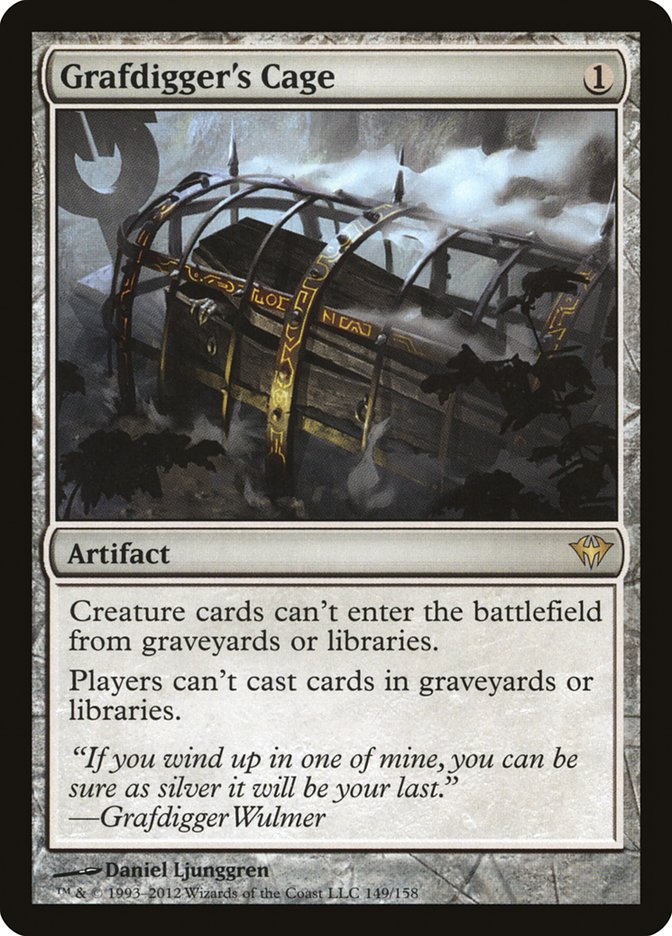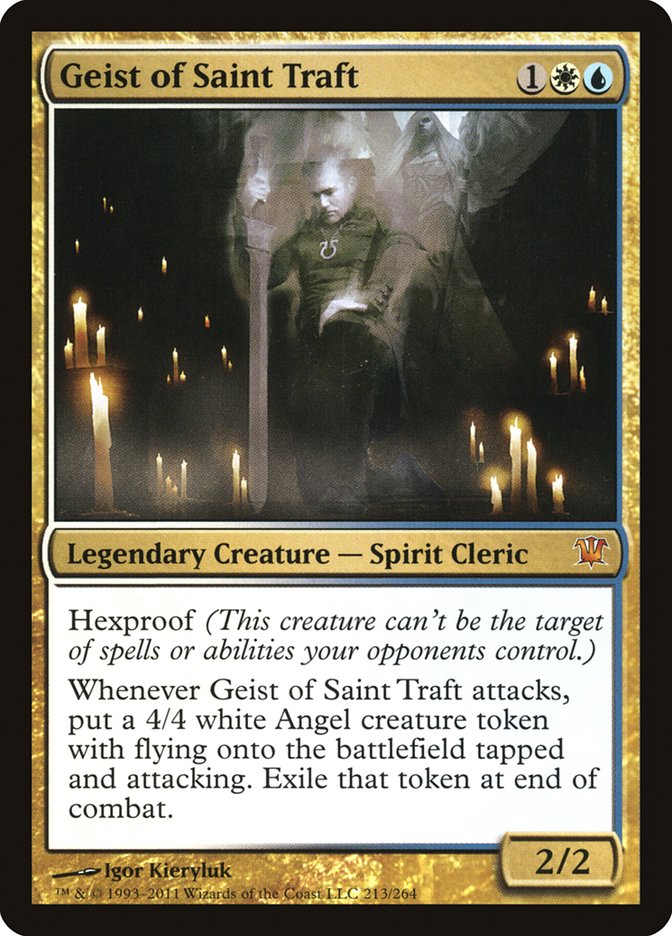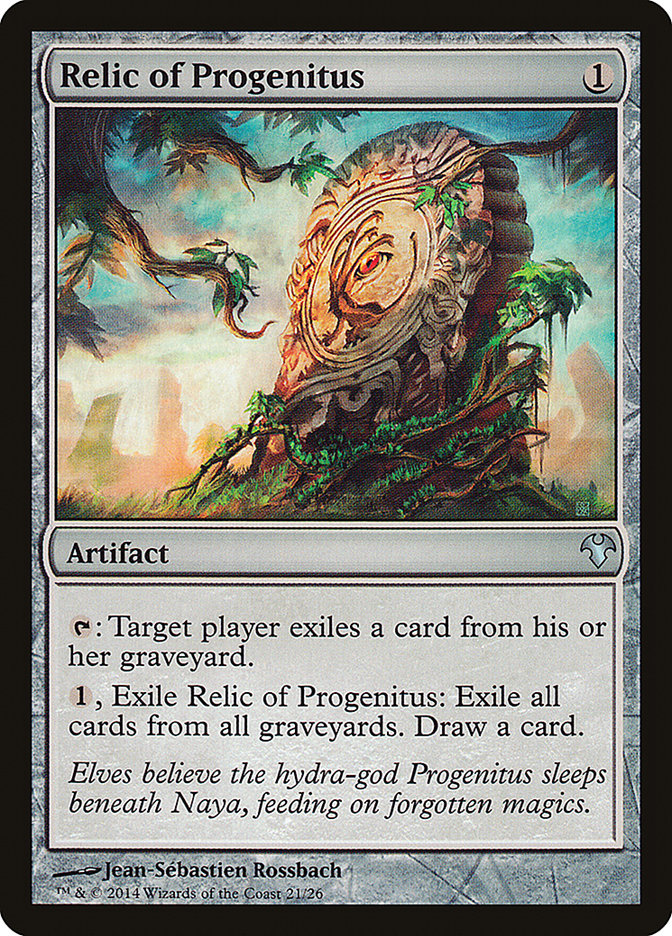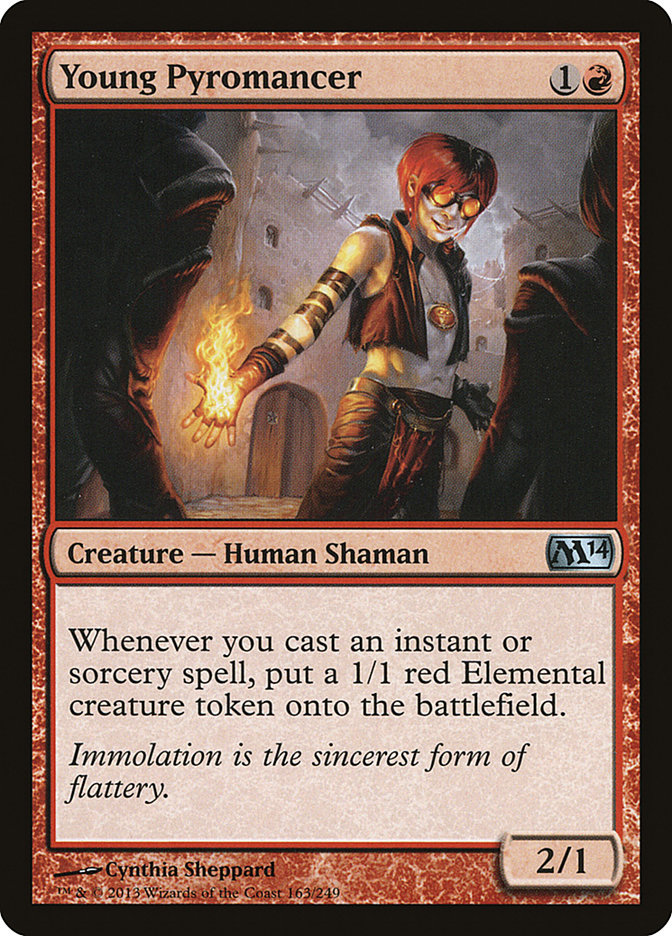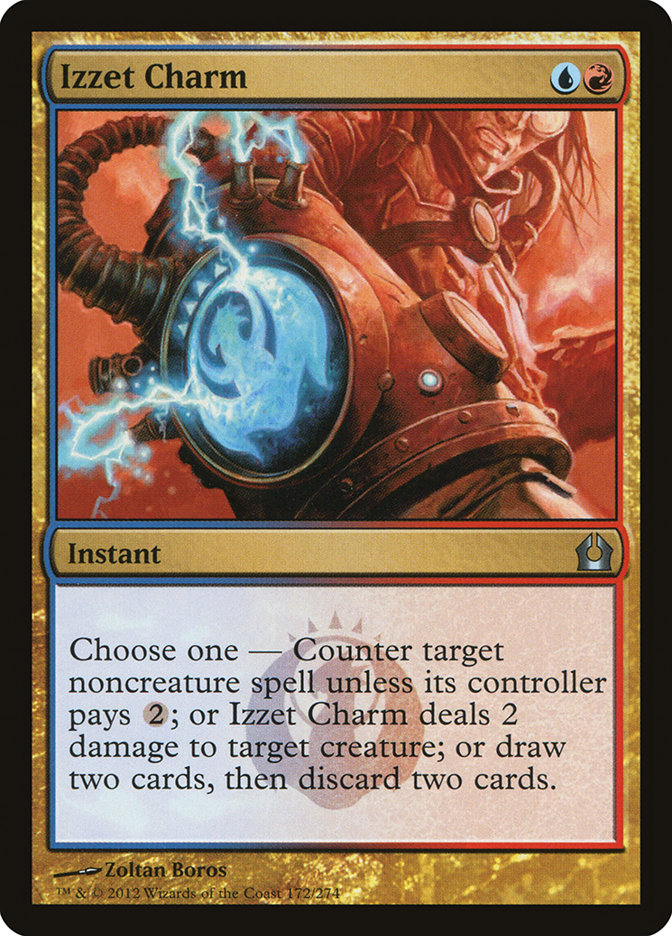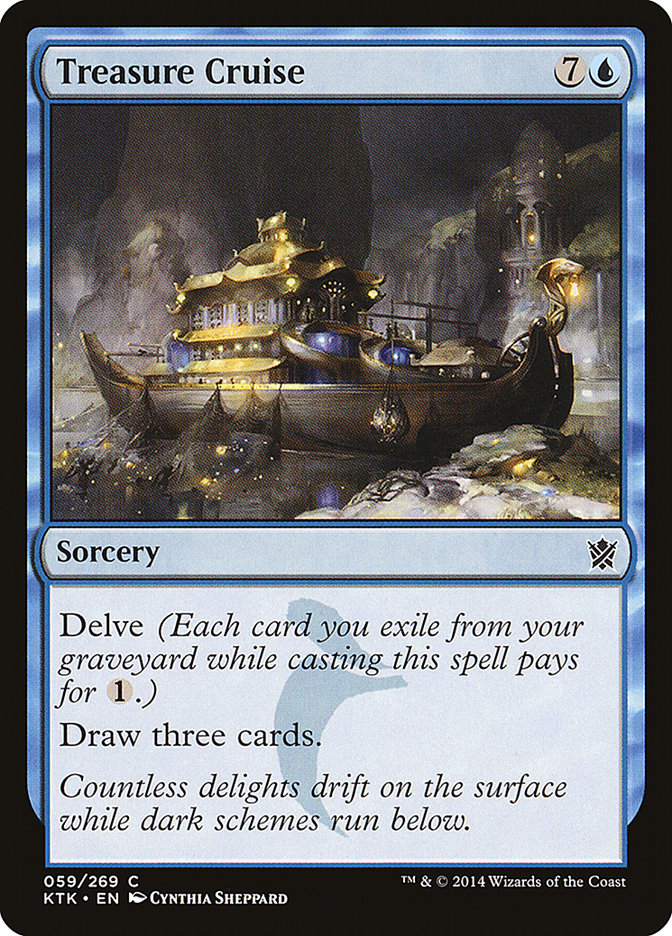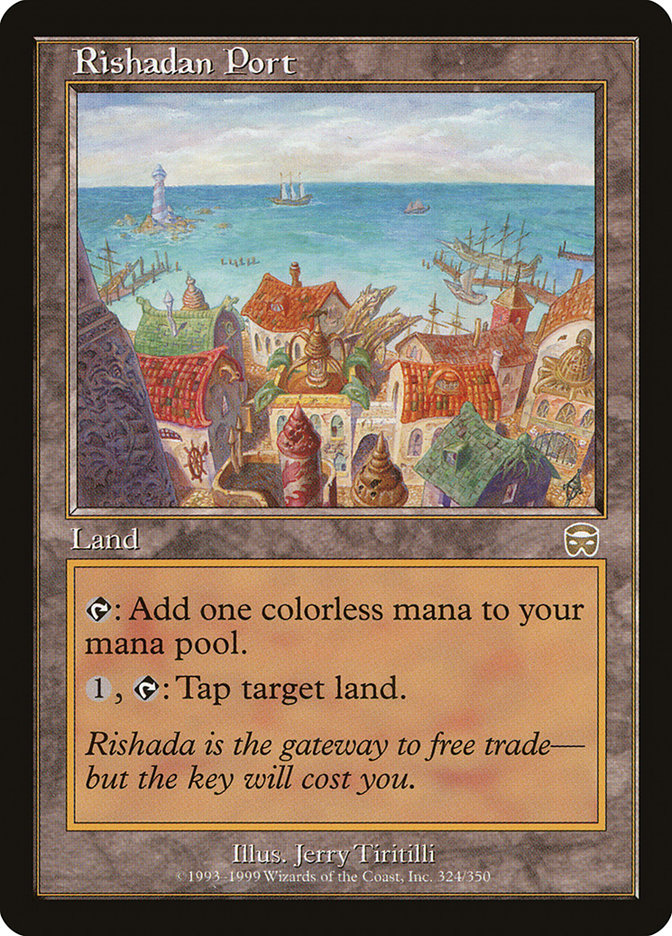My opponent opened game 2 with a Scalding Tarn for an untapped Steam Vents, then played Grafdigger’s Cage.
After dying on turn 4 in game 1 to a pair of 13/14 Fatestichers, he was determined not to let it happen again. After dispatching my Young Pyromancer with a
Lighting Bolt on turn 2, he felt safe enough on turn 3 to tap out for a Serum Visions followed by a Delver of Secrets. Surely I couldn’t kill him on turn 3
through a Grafdigger’s cage.
Well, he was partly correct.
I untapped for turn 3, played a Seachrome Coast, and slid Geist of Saint Traft onto the table. He tried to hide his surprise/horror, but it was pretty
clear that the game was mostly over – just not in the manner he expected. A few turns later he was dead and the match was mine.
The Ole’ Bait and Switch
Last Sunday I played in a Modern Elite IQ in Pennsylvania, picking up the Channel Fireball Jeskai Ascendancy combo deck from the World Championships:
Creatures (4)
Lands (22)
Spells (34)

The deck looked pretty awesome, and considering that Modern was only a small portion of Worlds and that people in Eternal formats are often slow to adapt,
I figured it would be an unexpected and powerful choice for the event. I assumed that while most people would have an idea that the deck existed, they
would not really fully understand it, and more importantly, would have never actually played a game against it.
I was correct.
After playing the deck a bit online in the week leading up to the event, however, I came to truly despise the sideboard. Most decks were bringing in all
manners of graveyard hate against me to help disrupt the Fatestitcher portion of the combo and my delve spells, which made the semi-transformational
sideboard plan of moving into a Gift’s Ungiven/Unburial Rites deck seem very silly.
The whole point of the transformational sideboard plan was to get around hate cards, not more directly walk into them!
While the Gift’s Ungiven package may have had it’s place in certain matchups, I was very unimpressed. However, I am a true lover of transformational
sideboards, and this deck was perfect for one. The combo itself only really took up eight cards, and most of the cards in my deck like Lightning Bolt, Path
to Exile, Remand, and Treasure Cruise were already the top cards in the format. Even the secondary cards like Izzet Charm and Faerie Conclave were more
than serviceable. This made it very easy to swap the combo out, and it didn’t take long to find a plan that I liked.
If my opponents wanted to board in their anti-combo cards like enchantment removal and graveyard hate, let em!
I’ll just be getting ’em dead with some of the best cards in the format. This left me with essentially two decks:
Creatures (4)
Lands (22)
Spells (34)
- 4 Lightning Bolt
- 4 Serum Visions
- 3 Remand
- 3 Path to Exile
- 4 Gitaxian Probe
- 4 Thought Scour
- 3 Izzet Charm
- 2 Treasure Cruise
- 3 Dig Through Time
- 4 Jeskai Ascendancy
Sideboard

This was the maindeck, and I made some slight changes based on testing and making sure I was properly prepared for my sideboard plan. One of the most
important things about doing a transformational sideboard is making sure that your sideboarded deck is the 60 you really want.
For almost every game 2, I was sideboarding into this to start:
Creatures (11)
Lands (21)
Spells (28)
- 4 Lightning Bolt
- 4 Serum Visions
- 3 Remand
- 3 Path to Exile
- 4 Gitaxian Probe
- 4 Thought Scour
- 2 Izzet Charm
- 2 Treasure Cruise
- 2 Dig Through Time
Sideboard

While I would also often be bringing in the Dispel and maybe Wear//Tear, this was my starting configuration, and honestly it looks like a normal Jeskai
Delver deck. While Izzet Charm is slightly inefficient and having two Dig Through Time instead of two Treasure Cruise is a slight downgrade, for all
intents and purposes this is a completely different deck with a swap of only eleven cards.
Most decks would still have some of their removal in because it can help to break up Fatestitcher, but no deck was adequately prepared for Geist of Saint
Traft. In essence the deck became a turn 3 combo deck, as you would resolve Geist and then blow things up for a few turns with Lightning Bolt, Path to
Exile, and Remand while Geist won the game singlehandedly.
There was also a third deck in there as well, which essentially just added Young Pyromancer in as another element to the combo deck. Young Pyromancer does
a fantastic job of providing an army of blockers, and even a few random 1/1s can quickly become lethal with a Jeskai Ascendancy and a few spells.
Occasionally, I would shave a few of the weaker pieces for a few Young Pyromancer to add another angle of attack to the deck. This also worked against
decks like G/W Hexproof where you still want to combo because your removal is dead because it gave you a solid source of blockers and another way to win.
The Set Up
I made a few slight changes to the initial list to facilitate my plan, as I wanted to make sure that each deck was balanced.
The first was to swap the fourth Izzet Charm for the fourth Lightning Bolt. I’ve never been a big fan of Izzet Charm in general, as while it is a nice
hedge card, it is both inefficient and difficult to cast. Spell Pierce and Lightning Bolt are so good because they cost only one mana, and two is so much
more than one. While the draw two/discard two effect is nice when you have a Fatestitcher or two rotting in your hand, it really is only good in that
scenario and is just card disadvantage.
Lightning Bolt, on the other hand, is one of the best cards in the format, and the cheap removal keeps you alive while you set up. It is also a one-mana
spell, which can be very relevant when you are starting the combo, and most important of all is how important it is in our post sideboarded Delver deck.
What reasonable Delver deck would only have three Lightning Bolt?
Another slight change that might have happened even without the sideboard plan. Like the difference between Lightning Bolt and Izzet Charm, Treasure Cruise
costing one is so much more efficient than Dig Through Time costing two. When I was playing the original CFB list, I really didn’t like that I would get
glutted on two-mana spells, so this was a pretty easy swap as well. The fact that Treasure Cruise is so much better in the post-sideboard Delver deck is
also a very important factor.
Playing the Deck
For those unfamiliar with the deck, here is the basic rundown.
Unlike the Birds of Paradise/Noble Hierarch versions of the deck, this deck is not built on speed. Rather it is a combo/control deck that seeks to control
the game and craft its hand while it kills things and draws cards. Eventually you have stifled your opponents’ gameplan enough and opened yourself a nice
window to combo kill quickly in one turn.
The combo kill often comes from unearthing Fatestitcher and using it to untap your lands for each spell you cast. This means each one mana spell you play
is free, and you can keep chaining spells until your draw and discard away another Fatestitcher and begin to gain mana. You then can tap down your
opponent’s blockers, play more spells to untap your Fatestitchers, and attack for lethal.
Faerie Conclave is also an ingenious way to produce mana without Fatestitcher that also gets around graveyard hate. Activate the Faerie Conclave, and then
with every spell you play, it untaps and you get another blue mana. You often start going off with only a single Faerie Conclave or Fatestitcher in play,
but because you see so many cards while going off and get to discard so much it is very easy to get a Fatestitcher into the graveyard to press the combo
forward.
Also note that Gitaxian Probe is a great tool for going off, as it allows you to spend your last mana on either Fatestitcher or a Faerie Conclave
activation and then cast Probe for free to untap them.
Matchups
I played against a wide variety of decks in the event, and it’s pretty important to know what your opponent’s deck is capable of when figuring out your
gameplan.
The most difficult card to play against is Abrupt Decay, as it can take out your Jeskai Ascendancy no questions asked. What you often need to do is make
sure you have more time to set up, and you usually do as decks that play Abrupt Decay are often on the slower edge of the spectrum.
This setup can mean making sure you have extra mana and a few instants, so when you start to go off, you play a few spells in response to the Abrupt Decay
to make some extra mana, and then hopefully cast another Jeskai Ascendancy and keep going.
My favorite plan against Abrupt Decay decks and other slow, controlling decks is to just cast my Fatestitchers. They often don’t have a ton of good ways to
kill them, and you don’t really mind if they do because they end up right where you want them anyway. You can use Fatestitcher as a Rishadian Port to tap
down your opponent’s lands both on their upkeep, and then on your draw step if you want to go off that turn. This can keep them off of Abrupt
Decay/countermagic and give you a window to go off.
Otherwise you just need to understand what role you need to be taking. Against other combo decks you are going to need to be as fast and disruptive as
possible, while against fair decks with a lot of creatures you can sit back, kill things, and find the right time to go off.
Like most combo decks, it’s also important to just know when you just need to go for it and try and go off. You can’t play around everything all the time,
and sometimes just need to jam.
The Event
The deck performed wonderfully at the event, and I made it all the way to the finals before a Sultai Faeries/Tarmogoyf deck with discard, counterspells,
and Abrupt Decay finally took me down. Careful Fatestitcher play gave me a solid shot to win game 1, but I couldn’t find a Jeskai Ascendancy in my top 30
cards, and game 2 saw me board into my Delver deck but get out matched by a pair of Tarmogoyfs.
The sideboard plan got people all day, as almost every round I would win game 1 with the combo, and then win game 2 with my creatures while they would sit
around on their Grafdigger’s Cages, Wear//Tear, and Rest in Peaces.
The deck was very powerful and a blast to play, and I would highly recommend it for your next Modern event. While the sideboard plan loses a bit of it’s
luster when it’s not a surprise, there are always new surprises to look for.
What if we started as a Jeskai Delver deck and boarded the combo?
Creatures (12)
Lands (20)
Spells (28)
- 4 Lightning Bolt
- 4 Serum Visions
- 2 Lightning Helix
- 2 Remand
- 3 Path to Exile
- 4 Gitaxian Probe
- 4 Thought Scour
- 3 Treasure Cruise
- 2 Dig Through Time
Sideboard

Whatever you do, just make sure you keep em guessing!


